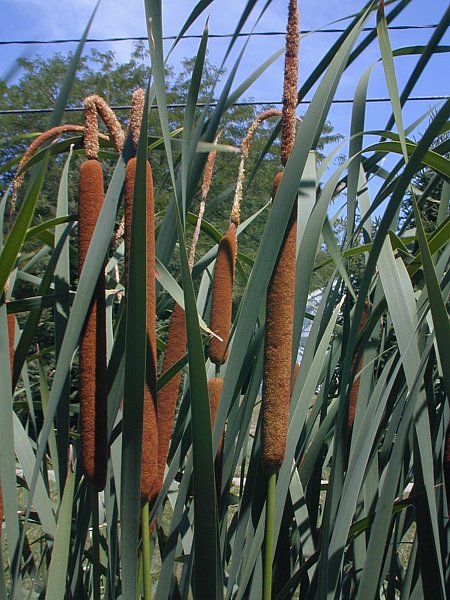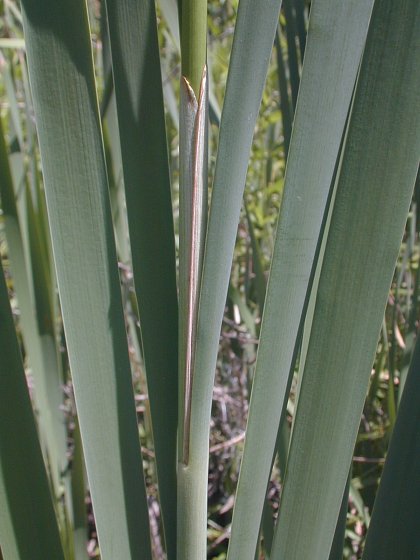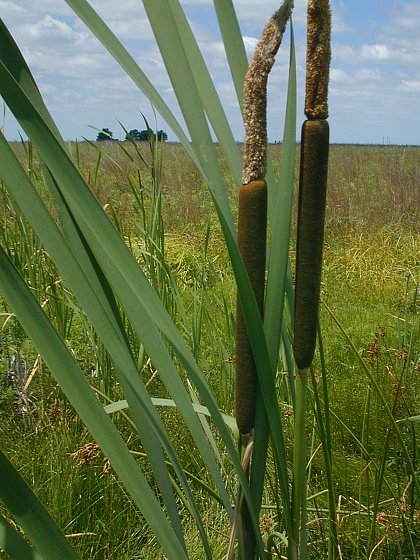Description: This perennial plant is about 4-9' tall and unbranched, consisting of 6 or more leaves and a flowering stalk. This stalk is light green to green, glabrous, stiff, and round in cross-section (terete). The leaves are up to 7½' long and 1" across. They are linear, green to bluish grey (often the latter), hairless, and rather flattened. Relative to the flowering stalk, the leaves are erect to slightly spreading; they originate from the base of the plant. Some leaves have a tendency to flop downward toward their tips. Leaf venation is parallel. There is a sheath at the base of each leaf. The flowering stalk terminates in a spike of staminate flowers and a spike of pistillate flowers. The staminate spike is above the pistillate spike; they are adjacent or separated by ½" or less. The staminate spike is up to 1' long and less than ¾" across; it is narrowly cylindrical in shape, light yellow to light brown, and densely packed with staminate flowers and abundant hairs. Each staminate flower bears 4 grains of pollen; its petals and sepals are reduced to bristles. After the pollen is released, the staminate spike quickly withers away. The pistillate spike is is up to 1½' long and less than 1¼" across; it is cylindrical in shape, greenish to blackish brown, and densely packed with pistillate flowers and abundant hairs. Each fertile pistillate flower has a stipe at least 1 mm. long, a single ovary, and a single style with a flattened stigma. Infertile pistillate flowers lack achenes, otherwise they are similar to the fertile pistillate flowers.

The
blooming period occurs during
early to mid-summer. Afterward, the fertile pistillate flowers are
replaced by achenes (one achene each). The pistillate spikes persist
into the autumn, releasing their achenes with chunky tufts of hair. The
root system produces thick starchy rhizomes and fibrous roots.
Vegetative colonies are often produced.
Cultivation:
The preference is full sun, wet conditions, and soil that is muddy or
sandy. This plant is an emergent aquatic that can tolerate standing
water up to 1½' deep. It can tolerate drought if the soil remains
moist. In more shady areas, fewer spikes of flowers are produced and
individual plants may die out. In suitable habitat, Common Cattail
spreads aggressively.
Range & Habitat:
The native Common Cattail is a common plant that occurs in every county
of
Illinois (see Distribution
Map).
In addition to North America, it is also native to Eurasia.
Habitats include marshes, swamps, seeps, borders of rivers
and ponds, and ditches. In marshes and other wetlands, this is
often one of the dominant plants. Common Cattail can survive in badly
degraded habitats, although it also occurs in natural habitats that are
less disturbed.

Faunal
Associations:
The caterpillars of various moths feed on cattails (either the leaves,
flowering stalks, flowers, or developing seeds). These moths include Bellura
obliqua (Cattail Borer Moth) and other Bellura spp.,
Dicymolomia julianalis (Pyralid Moth sp.), Limnaecia
phragmitella (Shy Cosmet), and Simyra insularis
(Henry's Marsh Moth). Other insect feeders include Sphenophorus australis
(Cattail Billbug), the seed bugs Cymus
angustatus and Kleidocerys
resedae, and the aphid Rhopalosiphum enigmae.
The starchy rootstocks of cattails are an important source of food to
muskrats. The Canada Goose and other geese eat the rootstocks to a more
limited extent. Dense stands of cattails provide cover for many wetland
animals and birds; many wetland birds nest in cattail marshes and the
leaves of cattails are often used as nesting material. These wetland
birds include the Marsh Wren, Yellow-Headed Blackbird, Red-Winged
Blackbird, Common Moorhen, American Coot, various rails, and bitterns.
Photographic Location:
A drainage ditch in Savoy, Illinois, and the edge of a prairie swale in
Jasper County, Illinois.

Comments: Common Cattail is a wetland species that most people are familiar with. Sometimes it hybridizes with Typha angustifolia (Narrow-Leaved Cattail), producing plants with characteristics that are intermediate between these two parents. Such plants are referred to Typha × glauca (Hybrid Cattail). Because the characteristics of Common Cattail, Narrow-Leaved Cattail, and Hybrid Cattail overlap with each other, it can be difficult to identify individual plants in the field. Generally, Common Cattail is larger in size with green to greyish blue leaves that span over ½" across. Its pistillate spikes are often ¾" across or more and they can exceed 1' in length. The staminate and pistillate spikes of Common Cattail are adjacent to each other or separated by less than ½". Narrow-Leaved Cattail has slender green leaves that are ½" across or less. Its pistillate spikes are less than ¾" across and they are less than 1' in length. The staminate and pistillate spikes of Narrow-Leaved Cattail are separated from each other by more than ½" (usually by a few inches).